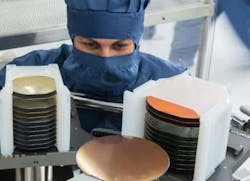Osram switches its red and yellow LED fabrication up to 6-in. wafers
Regensburg, Germany--Osram Opto Semiconductors is switching its fabrication of red, orange, and yellow LEDs, which are made from indium gallium aluminum phosphide (InGaAlP), from a 4-in. to a 6-in. wafer process; the company says that it is the first LED chip manufacturer to switch an InGaAlP process to 6 in. Osram is thus extending the fabrication of all its large-wafer LEDs to the 6-in. system and expanding its production capacity. The company began switching fabrication of its blue-emitting indium gallium nitride (InGaN) LED chips to 6 in. in 2011.
The latest switch involves chips for LEDs intended for an extremely wide range of applications. Red and yellow LEDs have many uses: as turn indicators, brake lights, and interior vehicle lighting in the automotive sector, in displays, for projection, for signage, and for color-mixing systems in the general-illumination sector. Osram notes that it was the first manufacturer to switch all LED colors worldwide to 4-in. wafers many years ago.
The InGaAlP red, yellow, and orange chips will be fabricated at the company headquarters in Regensburg; InGaN chips for blue, green, and white LEDs are also produced there, as well as in Penang, Malaysia.

John Wallace | Senior Technical Editor (1998-2022)
John Wallace was with Laser Focus World for nearly 25 years, retiring in late June 2022. He obtained a bachelor's degree in mechanical engineering and physics at Rutgers University and a master's in optical engineering at the University of Rochester. Before becoming an editor, John worked as an engineer at RCA, Exxon, Eastman Kodak, and GCA Corporation.
